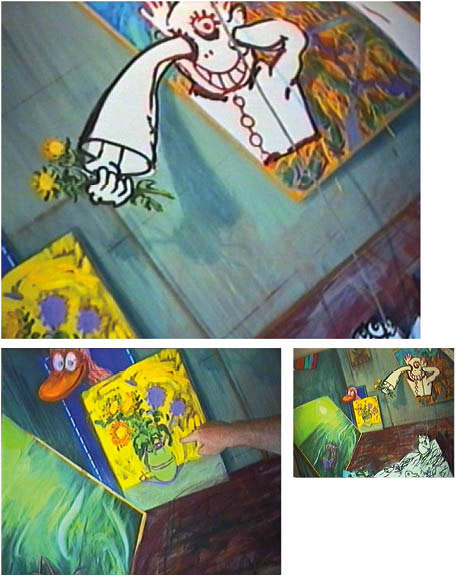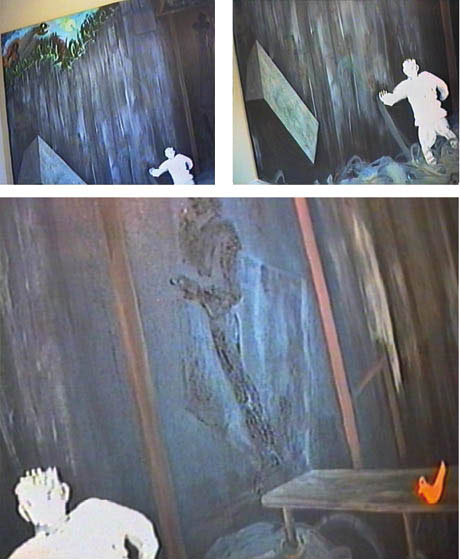Chapter 10:
Person-in-situation (2)
– Experience and questioning
This is the second of a series of projects that look at the person-in-situation. In the first project the focus was on a historical exhibition and getting close to the strategies two visitors, Anne and Rikke, used to create meaning out of the design of the exhibition in question.
The second project is about an art exhibition on famous Danish painter Ole Sporring at Sofienholm, an art gallery in the suburbs of Copenhagen. The two visitors, Jakob and Gunnar, try to find some relation and meaning in the exhibition as a coherent design and in the dissemination of this one-man exhibition.
The art of seeing
In their excellent book, The Art of Seeing: An Interpretation of the Aesthetic Encounter,authors Csikszentmihalyi and Robinson try to encompass which factors are meaningful when visitor and artwork meet. Their research is a methodological mix of qualitative individual interviews and quantitative enquiry. The informants in their study were not ordinary visitors, but rather 57 curators from 17 very different institutions. In their research, the informants talk about certain works of art they have selected that mean a great deal to them personally. In the research interviews the informants use their own examples as a prototype for the themes they talk about.
In my project, I narrow the focus even further by choosing two ordinary visitors without any specialised art or art history degrees or training. I selected a specific exhibition to function as the pivotal point of their experiences. Instead of interviewing the informants, my analysis is based on a walk-video and the conversation the informants engage in while looking at the exhibition. While Csikszentmihalyi and Robinson focus specifically on the artwork, my theoretical starting point is the visitor. I examine the person-in-situation and the construction of meaning in their experience from a phenomenological standpoint.

 Ill. 10.1: Paint yourself, NOPIP, 1999. The three small men think the old pictures need some pepping up. Will they be discovered before making mischief?” Screen dumps from the walk-video. Ill. 10.1: Paint yourself, NOPIP, 1999. The three small men think the old pictures need some pepping up. Will they be discovered before making mischief?” Screen dumps from the walk-video.
Relations and experiences
My analysis focuses on the relations the two visitors create and shows that they create at least four of them. First, by focusing on the details, they create internal relations between items in an individual work of art, which in turn helps them to interpret a specific painting. In addition they also create internal relations between different paintings, e.g. between the sunflowers in the hands of the artist and the sunflowers in one picture related to yet another version of sunflowers. There is also the example of a turned over can of red paint that is similar to another can with red paint in a different painting.
Next, via their observations and conversation they create many external relations to something they associate with outside the works of art. When Gunnar creates a connection between the painted Saurians and snakes to Nordic mythology and the snake pit, he is simultaneously revealing a frightening and unpleasant experience. Another example is when Jakob connects the picture with the lamp that shines darkness instead of light to an everyday experience he has had with his son about light. The image of a bitten ear creates two relations; one to Van Gogh’s missing ear and the other to Mike Tyson biting someone’s ear in the boxing ring.
Third, on a simple level, recognition relations are created because they recognise references to especially well-known Van Gogh paintings, turning the experience into a kind of test of their knowledge of art. They also recognise many of the elements based on common knowledge and experience of the world around them: cell phones, elephants, ducks, swords, bicycles, sheep, ears, cans, flowers etc.
Finally they also see aesthetic relations when they move out of the stories and out of the multitude of references in the paintings. They have an aesthetic gaze when they look at the composition, the formal elements like colour and the varied structures, which can be fine vs. rough, blurred vs. clear or smooth vs. textured. They wonder about the skills of the artist.
The four relations can be seen as an analytical tool to clarify how the experience is created in relation to the specific works of art, but the experience of the visitor is much more than just the reaction to the actual paintings and an attempt to understand them, as marvellous as they can be. The experience is looked at using the person-in-action and the performance is the relation between the two visitors, but also the other visitors in the room. The visitors’ use of movement and movement within the exhibition room, and thus many contexts, influence their experience and are incorporated in the phrase person-in-action.
The Attention Model creates a more precise understanding of the many elements that influence the experience of visitors. In the model, we made the common sense idea of experience more operational by dividing the experience into the following four fields: action, emotions, values and knowledge (Gjedde & Ingemann 2008).
The action field has to do with the everyday activities involved in being a visitor who makes informed choices about specific activities. At the exhibition, we use not only our eyes, but also our whole body to interact with the exhibition. We move our entire body from one room to the next. We move from one picture to another. We move back and forth at a variety of distances in relation to the artwork. We can move in time and space and see the whole exhibition in a few minutes or we can become more familiar with the exhibition by moving slowly through it.
Jakob and Gunnar are slow and thorough, using their bodies extensively to vary their distances to the artwork. They point and explain using their arms and bodies. They turn their bodies towards one another and talk, enhancing their expressions. They often look at each other and their body language to receive confirmation or to indicate a contradiction.
The emotional field is the emotional connection between objects and people and between people. First of all, the informants are looking forward to being together and experiencing the exhibition. They are curious and open-minded and pleasantly anticipate what is going to happen. From the beginning they feel well-accepted by him, the artist, and they confidently allow themselves to be drawn in by his universe, eagerly involving themselves in a dialogue with him. They encounter the tremendous amount of expression in the artworks, but also the humour and the creative turn-arounds. They are on an adventure and go exploring. They become irritated when the challenge becomes too overwhelming and they are unable to create any reasonable meaning, e.g. when they encounter the room with innumerable sketches.
The value field is related to collective and personal norms, morals and value systems. If one has a rather respectful attitude toward art, and especially to the renowned artist Van Gogh, the obviously disrespectful reuse of his great works of art can be a provocation. If one believes art must be aesthetically beautiful, the obvious brutality and grotesqueness of the paintings contradicts the idea of mainstream painting and means they will perhaps be rejected and avoided. In addition, the nearly obscene use of e.g. religious symbols such as Christ on the cross can be highly provoking in this new contextualisation.
My two visitors seem to be quite accepting of the artist’s universe and are not provoked due to their values or their personal and collective values. Nevertheless, they discuss the aspect of different types of reactions in relation to other people’s values regarding what might provoke, hurt or make them angry, perhaps causing them to reject the painting’s content and aesthetic form.

Ill. 10.2: “Searching the tomb of King Gorm, 1995”. Screen dumps from the walk-video.
The knowledge field includes obtaining new knowledge and encountering e.g. a new work of art that can actualise familiar knowledge. New knowledge was obviously gained by reading the signs associated with the individual works of art. The usual information of title and production year were included, but also a rather long, substantial text that pushed the interpretation in a certain direction.
One problematic question involves whether new knowledge is nevertheless gained through the artworks themselves. While looking at Searching the tomb of King Gorm they receive new knowledge from the painting due to its aesthetic composition and formal elements, including the colour, texture and line. Moreover they gain some knowledge about how the artist relates to his profession as a painter. They also learn that this painter uses certain aesthetic means to produce the image of a tomb that is not gloomy, but rather indelicate and humorous. He shows how it looks when the painter is searching for the tomb of King Gorm.
At the same time, the painting actualises the ancient story of the snake pit and the text on the sign with the title obviously functions as an important clue to retracing the long-forgotten thousand-year history of the old king.
Even in recognising what is well-known, some new knowledge is created about Van Gogh. They have seen the famous paintings in so many forms that they have nearly disappeared in their minds. It is through Ole Sporring’s recreations that the motives are renewed. Through displacement and a new contextualisation it is possible to see them with new eyes, thereby making them interesting and surprising.
They also gain new knowledge about the painter. The whole exhibition hall is filled with his paintings and objects, which provide a glimpse into his everyday life and demonstrate that he uses the television, newspapers, cell phones, toys, nature, homes, symbols, pictures of every kind etc. Each item is used and transformed by him into his funny but also cruel universe. The visitors got the feeling that they wanted to meet him. Or they felt almost as though they had already talked with him through his paintings. They have been to a splendid party with lively dialogue and left with a good feeling about the person they were talking to. The person behind the works of art may even be more than what the artist placed into the art history.
The personal and the universally human
In their research, Csikszentmihalyi and Robinson found that there are four important dimensions in the visitors’ experience of art: the perceptual, emotional, intellectual and communicative. They conclude that art promoters cannot make a universal functional plane to catch the attention of people with such different and unknown experiences (1990:189).
This conclusion is understandable because they are interested in finding the factors that lead to and expand an aesthetic encounter and that determine the aesthetic encounter as a flow of activity. At the same time, however, by isolating their focus and letting their informants talk about only one piece of art taken out of context, I believe that they do not reach their aim of understanding what occurs in a real exhibition.
There is more. In my research the whole narrative field is involved and defined as the building, the exhibition rooms, the works of art, the installation, the signs, and the visitors, both mind and body. This becomes clear through the recordings from the walk-video, which registers my visitors’ bodily movements and their conversations [1].
Their personal experiences can be seen as universally human within the framework of the pragmatic philosopher John Dewey and the phenomenologist Alfred Schutz. My visitors see the experiences of everyday life as superior to what Schutz sees as the other “regime of meaning”, such as dreams, plays, religion, science, insanity and art, which are modifications of the archetype of everyday life (Schutz 1961:230).
From this point of view, the analysis of the different relations and then of the four experience fields reveals that it is the richness of the works of artwork in their context combined with the richness of the visitors that extends their experience far beyond their pre-understanding of the exhibition, which is demonstrated in the above analysis of the walk-video.
In this chapter, I have shown that the richness of looking is more than the aesthetic encounter in isolation. The broader perspective shows that the influence is not only the constructed artworks, their installation, their stories, and their titles, but also the visitors in their effort to see and especially converse and listen to one another, all of which is crucial to understanding and learning in an exhibition. The combined actions of mind and body should be taken into consideration in the construction of horizon broadening exhibitions and dissemination must be made a bigger part of the overall design [2].
Notes
[1]
My research has many connections to the understanding of the museum experience model proposed by Falk and Dierking (1992) and focuses on the physical, personal and social context as influential to the experience as a whole.
[2] In an extensive project on the influence of conversation between visitors on learning in museums, Leinhardt and Knutson (2004) have identified different kinds of explanatory engagement, which are grouped together and organised in terms of ‘making lists’ (e.g. naming objects); ‘personal synthesis’ (connections made between what is observed and one’s own individual world); ‘analysis’ (comments of an analytical/descriptive nature); ‘synthesis’ (the connection between objects and different phenomena); and, lastly, ‘explanations’ (answers to questions on mechanisms, processes etc.).
The most interesting result is that the visitors wanted to be challenged by controversial questions and differing points of view. This stimulates discussion even further and allows visitors to explore what they think.
|



